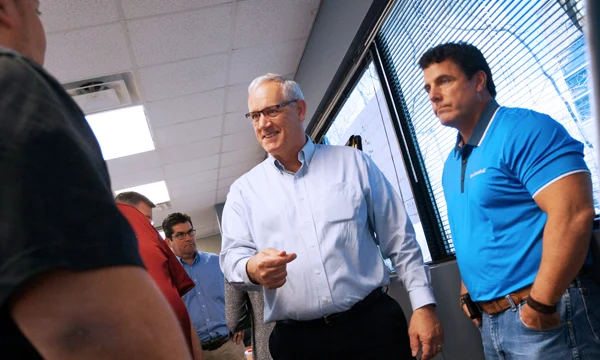
From Maintenance Tech to LCI Certified Reliability Engineer: Bret’s Journey
Introduction:
Bret Berry, a professional with a background in maintenance, experienced a significant career turning point in March 2020 when the COVID-19 pandemic disrupted operations. Around this time, an experienced reliability engineer left the company, leaving behind machines with sensors that were underutilized and unmonitored.
Background:
With a background primarily in maintenance, Bret was initially unaware of the world of reliability engineering. Eager to explore this new frontier, he sought guidance from experienced professionals in the field, including colleagues at his company who had previously trained with LCE. Through diligent research, Bret discovered the opportunity to enroll in the Reliability Engineering Certification (REC) program, offered by the Life Cycle Engineering Institute. His journey began with a Reliability Engineering Excellence class, where he immersed himself in understanding the responsibilities a reliability engineer has around loss elimination, life cycle asset management, root cause analysis and risk management.
Issues:
As he progressed in his studies, Bret recognized the significance of performing a criticality analysis to identify mission-critical or assets critical to operation in order to optimize maintenance plans for that asset.
As an assignment from the first REC class (and part of his final capstone work product), Bret focused his efforts on a criticality analysis of the galvanizing line furnace—a machine with high downtime costs and severe disruption to his operations upon failure. He observed his company’s investment in a few trial vibration sensors on non-critical equipment, lacking a clear purpose for their use, and with no plans to expand the program while the sensors collected unused data. Fortunately, performing root cause analysis, failure mode effects analysis and proposing a condition-based monitoring solution were all assignments from his Life Cycle Institute courses: Root Cause Analysis, Risk-Based Asset Management, and Predictive Maintenance Strategies. These classes gave Bret the tools necessary to construct a business case for implementing a strong vibration analysis program. Bret had the additional advantage of seeking guidance and coaching from his LCE subject matter expert instructor who mentored him throughout completing his REC studies.
Bret proposed this business case to management, who agreed it was a necessary step towards their goals of world-class maintenance. He worked diligently to complete a full criticality analysis of the line, ensuring money wasn’t wasted monitoring non-critical machines and increasing the potential return on investment for the project. The initial rollout of vibration sensors focused only on the most critical machines; within a mere 48 hours of rollout, the team identified a faulty roll bearing in the furnace, a problem that, if left unaddressed, would have incurred upwards of $500k in downtime costs.
Excited at the big win, they continued the rollout to the other high-criticality machines, collaborated with the sensor company to ensure the proper predictive technology was being used in the right places, and began a failure modes effects analysis (FMEA); the FMEA would not only ultimately be a decision-making tool to drive maintenance plans in his organization, but also became the center of his REC capstone work product, resulting in the installation of over 150 vibration sensors on different equipment across the galvanizing line.
Impact:
Bret’s proactive approach and reliance on sensors yielding vibration analysis data allowed for strategic maintenance planning and the prompt replacement of the faulty bearing, which garnered him praise from plant management. The initiative translated into substantial savings for the company and earned him the trust and respect of his peers and superiors. His contributions extended to a failure modes effects analysis of the entire packaging line hydraulic plant, revealing persistent problems in the hydraulic system configuration that caused oil overheating due to continuous pumping and dumping into the tank when the line stopped moving, resulting in numerous hydraulic leaks and premature equipment failures.
Leveraging his knowledge and skills acquired through REC certification, Bret proposed a straightforward solution requiring minimal resources. Utilizing a relief valve and a few pipe fittings, the new configuration improved the cooling of hydraulic oil, effectively preventing overheating and leaks and dropping the oil temp by ~50 degrees F. This change not only boosted machine performance but also reduced maintenance costs.
Bret’s success in implementing these changes led to a remarkable career transition, earning him the title of Reliability Engineer Tech. This transition significantly improved his work-life balance and job satisfaction. As he continued to expand his expertise, he played a pivotal role in redefining training and growing a reliability team within his organization. Over the next few years, Bret would go on to perform a criticality analysis on other production lines within the facility and roll out vibration analysis, oil analysis, and thermography programs to all critical machines on these production lines. Using the teachings and materials from his certification classes, he was able to start tracking KPIs (key performance indicators), building performance goals, and tracking cost avoidance due to the predictive and condition-based maintenance programs implemented throughout the facility. The total cost-avoidance across the facility due to these programs was upwards of 7 million dollars over a 3-year period.
Motivated by the success he achieved through the REC program, Bret wanted to grow his management skills and continue to further his career. He entered the Maintenance Management Certification (MMC) program soon after completing his REC to learn about building a problem-solving culture, managing programs and supporting maintenance personnel productivity and development. Through certifications and training, including the Reliability Engineering Certification and Maintenance Management Certification (MMC), Bret developed into a change agent within his organization, evangelizing the cultural and financial impact of reliability within the company. He integrated reliability best practices into the organization, resulting in cost savings and enhanced maintenance processes.
With his prior success as a reliability engineer, a result of the REC classes and earning the MMC certification, Bret successfully secured a position as a Maintenance Manager. In this capacity, he applies the skills he acquired from the MMC courses, leveraging his extensive knowledge of reliability best practices and past experiences to drive the maintenance program towards world-class standards. Notably, Bret’s team has already introduced a CMMS program, and he is now setting out to explore the uncharted territory of implementing predictive maintenance technologies.
In summary, Bret Berry’s journey from a maintenance background to becoming a Certified Reliability Engineer has brought about significant positive changes for both his career and his organization. His proactive approach, coupled with knowledge gained from certification programs, has not only saved costs but also improved overall operations and the organizational culture.
Quick Summary
Bret Berry, a maintenance professional, embarked on a transformative journey into the realm of reliability engineering and maintenance management through the Life Cycle Engineering Institute’s Reliability Engineering Certification (REC) and Maintenance Management Certification (MMC) programs. Armed with newfound knowledge, he:
- Implemented risk-based asset management and reliability engineering processes and practices, such as asset hierarchy construction, criticality analysis, root cause analysis, FMEA, and risk-based corrective actions
- Created substantial cost savings for his company – upwards of 7 million dollars
- Advanced his career
- Learned valuable tools to help cultivate a continuous improvement mindset within his team
Additional Information
Discover the pinnacle of excellence with the Life Cycle Institute offering world-class programs and training led by experts in instructional design, asset management, and reliability.
To unlock your organization’s full potential, please email us at info@LCE.com or visit www.LCEMarketplace.com.



